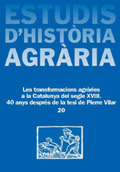The transformations of the rural world in the Lleida counties. The limits of growth. 18th century
DOI:
https://doi.org/10.1344/eha.2007.20.69-88Keywords:
Lleida region, 18th century, colonization, production limits, indebtedness, feudal rentsAbstract
In this work we analyse Pierre Vilar’s contributions to knowledge of the Lleida region and new insights subsequently obtained by other historians. Vilar details the agricultural changes of the 18th century, among which he emphasizes demographic and agricultural progress, the limitations of that progress, the social tension that accompanied it and the intensification of trade relations of the Lleida region with the rest of Catalonia. These new works, frequently employing local sources, explained the demographic and agricultural chronologies and the role of precarious contracts in places, especially in the Segrià, which had returned to feudal hands after the depopulation of the 17th century, reinforcement of the banalitats (obliging peasants to pay to use the ovens and mills of the manor) and the resistance and vitality of the feudal rent in the context of the agricultural expansion of the 18th century. The peasants attempted to overcome, in part, the difficulties of raising a family with very limited production potential by selling food products – basically wheat – in the market. These opportunities were not taken advantage of by broad sectors of a peasantry indebted and subjected to the payment of feudal rents. The income accumulated by landlords and by the incipient agricultural and commercial bourgeoisie would be the other component of the process.
Downloads
Published
Issue
Section
License
From issue 29 (2017), when submitting a proposal, the author retains the copyright but grants the journal the first publication of the work.
The texts will be disseminated under the Creative Commons licence Attribution Non commercial (CC-BY-NC) which allows the work to be shared with third parties, provided that authorship is acknowledged, the initial publication in this journal, the conditions of the licence are met and no commercial use is made.



